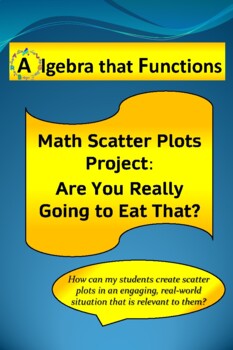Math Project Scatter Plots: Are You Really Going to Eat That? *DISTANCE LEARNING
- PDF
- Easel Activity
Description
PRINT and DIGITAL * * Makes distance planning so much easier!
Math Project Scatter Plots: Are You Really Going to Eat That?
This math project is a fun way for your students to use bivariate data that is highly engaging and relevant to them to construct scatter plots in a real-world situation! Your students will enjoy making choices about restaurants and meals they like to eat based on their personal needs and wishes. Students will organize the nutrition data of the meals they choose using tables and create scatter plots and equations of lines of best fit. All of the menus and nutrition data is included in the project!
Literacy and health are also elements of this project! Students will make conjectures and comparisons and write about the nutrition relationships of the meals they choose. This engaging and relevant real-world nutrition project is the perfect end-of-the-unit project on scatter plots. My students absolutely love this math project!
This scatter plot nutrition project is also a great way to end the school year for your students and for you!
*Scatter Plots
*Line of Best Fit
*Equation of the Line of Best Fit
*Data
*Tables
*Writing
*Vocabulary
*Nutrition
This product is a paid digital download from my TpT store
Algebra that Functions and it is for use in one classroom only. This product is also bound by copyright laws. Redistributing, editing, selling, or posting this item (or any part thereof) on the Internet are all strictly prohibited without first gaining permission from the author. Violations are subject to the penalties of the Digital Millennium Copyright Act. Please contact me if you wish to be granted special permissions!
You Might Also Like
Jokes to Start Class Set 1 Laugh in Class!
Jokes to Start Class Set 2 Laugh in Class!
Math Jokes to Start Class Set 1 Laugh in Math!
Math Jokes to Start Class Set 2 Laugh in Math!
Identifying Critical Information
MATH PROJECTS!
Math Project Equations Writing and Solving in a Fun, Real-World Situation
Math Scatter Plot Project: Are You Really Going to Eat That?
Math and Art Project Graphing Linear Functions
Math Project Functions Real-World Application Math Project
Math Project Linear Functions Open-Ended Real-World Application
Math Project Linear Functions Summer Jobs
Math and Art Project Graphing Systems of Linear Equations
Math Project Systems of Linear Equations Real-World Open-Ended Project
Math Project Linear Functions and/or Systems of Linear Functions Real-World Application
Math Project Systems of Linear Equations Real-World Sales Representative
Math Project Teens Shopping for Clothes on a Budget
Math Project Graphing Quadratic Functions Math and Art Project
Math Project Quadratic Functions Real-World Application
Math Project Linear and Exponential Functions Which Salary
Math Project Linear, Quadratic, and Exponential Functions Models
Math Project Volume of Cylinders, Cones, and Spheres Real-World Project
Math Project Aquarium Designer Volume of Cylinders, Cones, and Spheres
Rational and Irrational Numbers: Classifying Numbers into Sets
Exponent Properties: Exploring and Applying Properties of Exponents
Order of Operations: Exponents, Roots, Absolute Value
Real-World Application: Writing Linear Equations for Problems Related to Teens!
Exploring how m and b Affect the Graph of a Linear Function
Exploring Systems of Equations Cell Phone Plans
Writing Linear Equations in Function Notation for Real-World Situations
Beginning of Year Activity Math Bio Poems
Beginning of Year Activity Find Someone Like You!
Customer Tip!
You can get TPT credit to use on future purchases!
Go to your My Purchases page (you need to login). Beside each purchase you'll see a Provide Feedback button. Simply click it and you will be taken to a page where you can give a quick rating and leave a short comment for the product.
Each time you give feedback, TPT gives you feedback credits that you use to lower the cost of your future purchases.
Be the first to know about my sales, freebies and product launches! CLICK ON THE GREEN STAR next to my store logo to become a follower. You will receive updates about my store.






